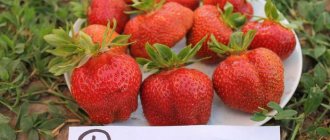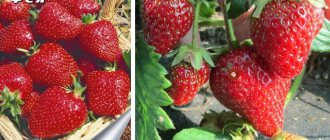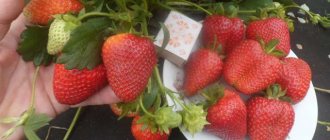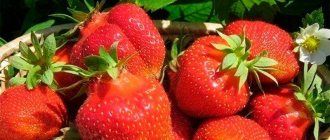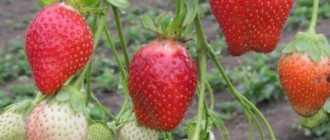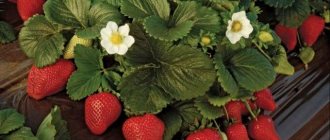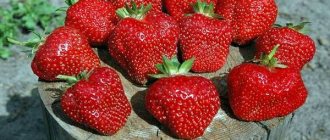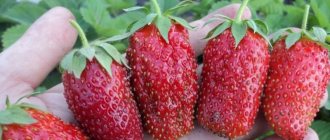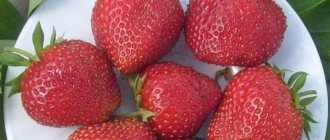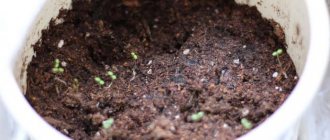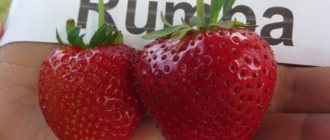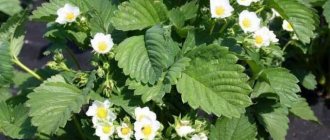Description of the variety
The plant has powerful bushes and strong peduncles that hold berries well, with an average weight of 100-125 g . The height of the bush can reach 40 cm , and the diameter is 50 cm . The wide leaves are colored matte light green. Their shape resembles a trefoil. The surface of the leaves is corrugated.
Among the advantages of strawberries:
- pleasant taste and aroma of fruits;
- large beautiful berries;
- good resistance to drought and low temperatures;
- high degree of resistance to most diseases.
The plant belongs to the early giants. In the first year, 1-2 flower stalks appear on the bush. An ovary of -10 berries is formed on them. In the second year, the bushes throw out up to 6 flower stalks.
In Russia, the variety is rare. Its disadvantages include the difficulty of acquiring planting material.
Origin, registration and recommended growing regions
“Fairy” was bred by Soviet breeders under the leadership of E.V. Koltsova back in 1970 by crossing the “Scarlet Sail” and “Nadezhda” (or “Award”) varieties at the Kuibyshev (now Samara) zonal horticulture experimental station. Since 1980, the variety has undergone state tests, and in 1988 it was included in the State Register (originator: State Budgetary Institution of the Samara Region Research Institute of Horticulture and Medicinal Plants “Zhiguli Gardens”). It is recommended for cultivation in the Volga-Vyatka, West Siberian and East Siberian regions, but in practice it shows good results in many other regions of Russia, in particular in the middle zone and in the south.
Planting material of the “Fairy” variety (seeds and seedlings) is offered by various domestic agricultural companies and nurseries
Reproduction
Strawberries are grown using seedlings. A separate bed is being prepared for new plantings. You can grow seedlings yourself from seeds or buy ready-made planting material. For planting in the ground, seedlings with a well-developed root system are selected. The length of the white roots should be at least 3-5 cm, and the diameter of the bark neck should be 6 cm .
Seedlings should have a whole apical bud and 3-5 leaves. Bushes intended for planting cannot be kept out of the ground for a long time. If the purchased seedlings cannot be immediately planted in the beds, they need to be buried in moist soil or the roots should be wrapped in damp moss.
Landing
The ideal soil for “Comrade of the Winner” is considered to be chernozem mixed with a small amount of peat. Its productivity depends on the correct planting. It starts with preparing the beds. They are located in a well-lit area. Soil with high acidity is treated with lime a year before planting. It is added to the soil at the rate of 1 cup per 1 sq.m.
Recommended:
- Plant at a distance of 50-55 cm. The row spacing should be 70 cm.
- Add a small amount of humus and 1 liter of warm water to the planting hole.
- Plant strawberries in cloudy weather.
- After planting, water by sprinkling every day for 1 week.
The root collar of the bush is buried at the same level as the soil surface. Before planting, the roots are well straightened. The roots should not be exposed during watering. It is better to place the beds in east-west directions. This ensures maximum illumination.
Watering
With proper watering, the berries grow large and juicy. Watering is carried out:
- On sunny days, 2 times a week using sprinkling method.
- In cloudy weather, strawberries are watered no more than once a week.
- During the ripening period, the frequency of watering is once every 10 days.
In cool weather, reduce the amount of watering. Moistened soil must be loosened.
Some of the ordinary water for irrigation can be replaced with herbal infusions. The last abundant watering of strawberries is done 1 month before the onset of frost.
Care and feeding
During the entire period of growing strawberries, weeds are pulled out from the beds, the soil is loosened and pests are controlled. Loosening begins immediately after the appearance of flower stalks. During this period, tree resin is recommended . 2 cups of ash are added per 1 sq.m of soil. For good plant growth, strawberries are fed with biofertilizers . An effective means for watering is nettle infusion.
The grass is filled with water and infused for at least 3 days. The infusion is sprayed on the bushes during the formation of the stem and the release of flower stalks. Top dressing is made from mullein and a solution of zinc sulfate 0.02%. To prevent the berries from falling to the ground and rotting, the bushes of the plant are sprinkled around the circumference with river sand.
Circumcision is performed early in the morning or late in the evening. This is done using garden shears. You cannot tear off your mustache with your hands. They are very strong. If they are torn from the stem, the bush can be damaged.
When leaving it is recommended:
- Be sure to loosen the soil at the end of summer.
- Do not dry out the soil before frost.
- In the fall, cover the bed with spruce branches or dry raspberry branches.
- To facilitate maintenance, they are covered with agrofibre.
The first feeding is carried out in early spring. To do this, use ammonium nitrate in the amount of 1 tablespoon per 1 sq.m. Ash is used as dry fertilizer. At least 2 glasses are scattered per 1 square meter.
In the summer, strawberry bushes are sprayed with a solution containing:
- 1 bucket of water;
- 1 cup wood ash;
- 1 cup garlic.
This product helps get rid of plant pests. During the formation of fruits, it is recommended to feed the berries with “Ovary” fertilizer. Before winter, all weeds and diseased plants are removed from strawberry beds. They themselves are covered with branches or covering material.
Strawberry queen of berries
The taste and aroma of strawberries will not leave anyone indifferent; it is not without reason that they are called the queen of berries. But this is not only a delicacy, but also a natural medicine and cosmetic product. The fruits of garden strawberries contain sugars, vitamins, fiber, carotene, manganese, phosphorus and many other essential vitamins and minerals that heal the human body.
Main signs of quality
Now there are about 20 thousand varieties of strawberries in the world, but only 73 are recommended for propagation, including varieties of early, medium and late ripening. Even the most demanding gardeners have plenty to choose from. But it should be borne in mind that the best varieties of berries must meet the following requirements:
- Productivity and size: up to a kilogram of berries can be collected from one bush; in the first harvest, the weight of one fruit should be at least 30-50 g.
- Aroma and taste: berries contain the required amount of acids and sugars, emit a specific aroma, and have a balanced taste.
- Required consistency: fruits are dense, skin is tender. The shelf life of berries and their protection from slugs and rot depend on these qualities.
- General stability: the crop must be cold-resistant, resist diseases, pests and not place increased demands on the composition of the soil.
What will the strawberries of the future be like?
Breeders have not yet developed the ideal type of berry. In the future, it should combine the following advantages:
- early ripening;
- high productivity;
- large fruit;
- sweet taste;
- suitability for transportation and processing;
- resistance to any climatic conditions and pests;
- good ability to reproduce.
Considering that such a combination has not yet been achieved, gardeners should choose berries that at least approximately fit into this standard. First of all, you need to take into account the peculiarities of agriculture in each specific region.
Diseases and pests
Manufacturers produce special preparations to control pests. The most popular of them are “Fitosporin” and “Colloidal sulfur”.
Among the factors that weaken plants and reduce resistance to disease:
- lack or excess of nutrition;
- excessive dryness or moisture in the soil;
- weeds.
In early spring, before the bushes appear, the beds are watered with hot water from a watering can. Its temperature should not be lower than 60 degrees. You can add a little potassium permanganate or copper sulfate to the water.
Among the most commonly used means for controlling pests and diseases of strawberries:
- Iodine . Used for spraying plants. The solution is prepared from 15-20 drops and 10 liters of water.
- Garlic infusion . Take 150 g of garlic per bucket of water.
- Mustard powder . The solution is prepared from 10 liters of water and 2 tablespoons of dry powder.
- Serum . The ratio of ingredients in the solution is 1:10.
To combat fungus, plants use chemical fungicides, and biological insecticides against harmful insects.
The pests that cause the most damage to strawberries are:
- Nematode . Caused by small worms that burrow into the plant. Affected bushes are burned. The soil is subjected to special treatment, and the bed is moved to another place.
- Strawberry mite . Completely destroys plants. Prevention of infection of strawberries is disinfection of seedlings before planting.
- Spider mite . It entangles strawberry bushes in garden cobwebs, which leads to drying out.
- Aphid . Clings to the leaves and stems of the plant. To combat insects I use garlic solution.
Enemies are wasps and birds.
Among the most common types of berry diseases:
- fusarium and late blight wilt;
- powdery mildew;
- gray rot;
- brown leaf spot.
Fungus on strawberries most often appears in beds that have not been cleared of old plants and weeds. They must be completely removed from the site before winter. In the spring, strawberries with various chemicals to prevent infection The most effective among them are Falcon and Euparen. Ordan is used for autumn spraying.
To maintain the health of the berries, it is necessary to comply with all growing conditions necessary for normal plant growth . Soil treatment, timely watering and fertilizing will eliminate the hassle of treating tangle diseases and controlling pests. To breed a variety, you should not buy its seedlings from strangers. Currently, “Kamrad Winner” can be found in gardening nurseries.
It is very useful to periodically change the location for setting up strawberry beds. It is not recommended to plant on areas of land previously occupied by colorful flowers. It is good to plant herbs next to the beds to repel pests. For example, lupins.
Purpose and use of strawberry Aromas
Rules for planting strawberries in open ground in spring, summer and autumn Planting patterns Photos and videos
The variety is suitable for both processing and fresh consumption.
- Due to the good yield, high transportability and keeping quality of Aromas berries, it is suitable for commercial production.
- Late ripening will please summer residents and gardeners, prolonging the pleasure from wonderful berries.
- It is good to use Aromas for freezing, providing yourself with vitamins for a long time.
- The NSD variety is better suited than others for growing at home on a windowsill and can please people who do not have land.
Growing remontant strawberries at home differs from growing them in the garden. To plant plants, you need containers or pots of a certain volume, prepared or purchased soil, and your own watering and fertilizing regimes. If you grow strawberries at home, you can enjoy the berries all year round.
Strawberry variety Kamrad Winner
Kamrad Pobeditel is a non-repairing variety of garden strawberries (strawberries) of medium late ripening, universal use. It is the brainchild of German breeders. Famous for its large fruit, it belongs to the symbolic group of giant varieties. It is also valued for its good taste, excellent immunity to disease and the ability to adapt to different climatic conditions. The variety is “long-lived” and can be grown for about 7 years without renewal, without reducing the yield or losing its excellent taste.
The plant is powerful, tall (35−40 cm), abundantly leafy, spreading. The mustache is powerful, thick, and is formed in small quantities. The leaves are wide, strongly corrugated, dark green in color. The flowers are large and white. Strawberry flower stalks are powerful, strong, very thick, located at the level of the leaves or higher, and are laid on the ground under the weight of the fruit. Comrade Winner forms quite a few flower stalks, in the first year of life only 1-2 pieces, in subsequent years - up to 6. Each of them can bear up to 10 berries.
The fruits of the variety are really huge, mostly comb-shaped, and can be broadly conical, without a neck. The skin is bright red and shiny. The achenes are yellow, shallowly pressed. The pulp is red, very dense, but not hard, with a fleshy consistency, without voids, very juicy and aromatic. The taste of strawberries is excellent. The berries are very sweet, but there is a barely noticeable elegant sourness. In general, gardeners like the taste of Comrade Winner, but they admit that it is not particularly outstanding - the same as Gigantella, which is also not famous for any “zest” in its taste palette.
The fruits are universal in consumption, excellent fresh, and are excellent for any processing and freezing. Thanks to their dense pulp, they are easily transported and easily tolerate short-term storage. Externally, the berries look very impressive - not strawberries, but apples! In the market, of course, Kamrad the winner could be in great demand, but for commercial purposes it is grown extremely rarely, living mainly on the plots of gardeners and amateur collectors as a rare valuable specimen. Why is it this way? Let's figure it out.
So, the giant variety produces truly huge berries weighing from 60 to 150 grams; they can reach 7 cm in diameter. The largest specimens are observed during the first harvest, but subsequent fruits are striking in size. It is worth saying that our hero is considered one of the largest-fruited, surpassing in this regard the famous Gigantella Maxim and the recently popular Japanese masterpieces Chamoru Turushi and Tsunaki. But not everything is so rosy. In terms of yield, Kamrad the winner is inferior to the above-mentioned fellow giants, and quite significantly. The fact is that although its berries are large, there are very few of them. According to reviews from gardeners, strawberries form very few flower stalks (as a rule, no more than three), and there are even fewer fruits on them - often one large “apple” ripens, sometimes it is possible to observe 3-4 pieces. Thus, even if we assume that you are lucky and absolutely all the berries are gigantic, the yield will not exceed 1.5 kg per bush. But if we return to reality, such an indicator will become just a dream. The maximum you can count on is up to 1 kg per plant. On average, the yield is approximately 500−800 grams. Of course, it depends on agricultural technology, so who knows, maybe you will be able to collect more than 1.5 kg of berries from a bush. Of course, it’s better not to even dream about the exorbitant 3 kg per plant, as the advertising of Chamora Turusi and Tsunaki shouts, although for these two Japanese women such a figure is also not entirely realistic, so you shouldn’t immediately take your eyes off the victorious Comrade.
The variety ripens in the mid-late period, but in different regions it can start the season either earlier or later, which is why confusion sometimes arises - some consider these strawberries to be late, others - mid-ripening, and others generally classify them as mid-early. The variety bears fruit once, but at the same time it is very extended. This happens because the berries take a very long time to ripen. Gardeners complain that because of this nuance they do not have time to taste the harvest - insects, slugs, birds and other “neighbors” are already tasting it.
Comrade the winner has excellent immunity, and in general, he is very “tenacious”, he can calmly exist on the site even without any care. But, of course, if you want to get tasty and abundant harvests, then you should take care of the plants. It is still necessary to carry out preventive treatments against diseases and pests in a timely manner to avoid surprises. By the way, this strawberry is very loved by various residents of the site - insects, birds, mice, moles. Therefore, take all necessary measures to protect the harvest from unnecessary mouths.
The variety has quite decent winter hardiness; in the northern regions it winters quite well under cover, without attacks. Spring frosts are also not particularly dangerous for plants. Strawberries have a high level of drought resistance, as well as heat resistance, which makes them very attractive for growing in southern regions with hot summers. Of course, to obtain better yields, it is necessary to provide the plants with regular, abundant watering, and it would also be a good idea to think about shading the plantings to protect the berries from the scorching sun.
In agricultural technology, the variety is quite standard; it requires the most basic care measures. The winner's comrade can be classified as a “strawberry for the lazy” group, but one should not expect excellent yields with minimal attention to the plants. The main thing that needs to be emphasized is providing the plantings with sufficient nutrition. This is especially important if you want to see apple-sized berries on the bushes. The main preference is given to mineral complexes; organic matter is added before planting and before flowering. Another agrotechnical nuance - avoid excessive thickening. Considering the size of the bushes, they should be planted at a distance of 50 cm; it is better to leave 70 cm between rows. This planting scheme cannot be called compact, so a reasonable question arises - maybe it is better to plant two bushes of a different variety in a certain area? If you are interested in a higher yield of berries per square meter of area, then it is definitely worth it. But since our hero is currently more of a “museum exhibit,” we will not talk about commercial cultivation in pursuit of productivity.
The variety is valued for its longevity. It can bear fruit stably over 5-7 years of use, maintaining the excellent taste of the berries and quite good yield. In fact, at present this quality is quite rare, especially for very large-fruited varieties, so Kamrada winner can to some extent be called special among the assortment of giant varieties.
What would I like to say at the end? This strawberry is very good, has decent taste, is easy to care for, and has excellent resistance to various diseases. And for those who want to have a curiosity on their plot that bears fruit like berries, apples, and, moreover, does not have a “foam” taste, Kamrad the winner will be a good purchase. Unfortunately, it is not particularly promising for commercial cultivation, and many gardeners abandoned it due to insufficient yield. But for connoisseurs of varieties that are different from the mass of others, our hero is very attractive and will become a wonderful unique “highlight” on the site.
Features of fruiting and consumer qualities of berries
The variety has an average and long ripening period: flowering begins in mid-May, and the berries ripen from the second decade of June (almost simultaneously with the Festivalnaya strawberries). Plants form a large number of peduncles (10-15 pieces), located at or below the leaves. The inflorescences are semi-spreading, multi-flowered, which ensures the setting and filling of more than 50 berries on the bush. They are collected 5-6 times. The first fruits are the largest (up to 35-40 g), often have a non-standard (comb-like, ribbed) shape. Subsequent berries are truncated-wide-conical or round, without a neck, weighing on average 10-15 g.
The skin of ripe berries acquires a dark red color and a glossy shine.
The pulp is red, juicy, dense with a pleasant sweet and sour taste and aroma. Tasting scores of fresh fruits are 4.0-4.3 points (out of 5), sugar-acid coefficient 5.6-6.2. The culinary purpose is universal. Berries contain:
| Nutrients and beneficial substances | Quantity |
| Sahara | 6-9% |
| Acids | 0,98-1,6% |
| Vitamin C | 55 mg% |
The variety has great productivity potential. According to the results of the tests, the average yield was 105 c/ha, and the maximum – 189 c/ha.
Fairy strawberries are used mainly fresh and for whole fruit jam, as they retain their shape and texture well during heat treatment
Strawberry variety Kamrad Winner from German breeders
The name of plants often reflects their real properties or taste. For example, strawberries of the Kamrad winner variety are one of the most delicious berries ever bred by breeders. This is why it got its name. To better understand the characteristics of this type of culture, it is worth taking a closer look at the photo and description.
Description of the strawberry variety Kamrad Pobeditel
The Kamrad winner strawberry is considered medium-late in terms of ripening. The plant's bushes are powerful. The description of the variety of bushes says that they are tall, reaching a length of about 40 cm. There are a large number of leaves, their shade varies from light to dark green. When strawberries bloom, the flowers are large and white.
During the annual period, it is capable of producing about 2 peduncles, and they will later grow into 10 berries. The maximum number of harvests from one peduncle is 12 pieces. The fruits are large, have a bright, rich color and a memorable taste.
Yield characteristics
The strawberry variety Kamrad Winner is characterized by a high level of productivity with proper care. Reviews suggest that the total number of fruits depends, in aggregate, on several factors:
- the fertility of the selected soil;
- properly selected agricultural technology;
- climatic zone of planting.
The plant bears little fruit in the first year of life, since during this period it only adapts to new conditions. However, with high-quality care for the berries, you can get a fairly significant harvest from the second year.
Advantages and disadvantages
Reviews from gardeners indicate that the main advantages of this type of berry include the following qualities:
- Taste qualities, it can be safely used to create delicious desserts.
- Solid weight of an individual fruit; the berries are considered medium in weight.
- Quite easy to care for, the variety is ideal for beginner gardeners.
- Comrad the winner is resistant to temperature changes and tolerates the off-season well.
- Comrade the winner is resistant to most diseases.
Despite such a bright prospect for Comrade the winner, she had a small fly in the ointment in her characterization. This spoon is due to the rarity of the variety and it will not be so easy to simply purchase a Kamrad winner by going to the first store you come across. Another drawback lies in fruiting only from the second year. Until then, gardeners may not understand whether they have properly cared for the strawberries or not. If a critical mistake has been made, it can be corrected, but too much time will be lost.
Description of fruits and harvest
Despite the small amount of harvest in the first year of fruiting, the plant will delight gardeners with the weight of its fruit. The fruits are quite large and can weigh up to 100 grams per piece. If quality care is provided, up to 2.5 kg of juicy berries can be collected from one bush. The strawberry variety Kamrad the winner has the following berry characteristics:
- dark red surface with elastic flesh;
- inside the fruit is light pink, with a dense structure;
- due to the high sugar content of the fruit, the taste qualities of strawberries are recognized as one of the best;
- Comrade winner is quite resistant to freezing;
- Strawberries are especially popular in restaurants, where they are served as a doping for expensive wines;
In order for all these characteristics to take place, it is important to properly prepare the strawberries for planting and carry out the process correctly.
Sustainability and agronomic recommendations
According to field assessments, the variety is relatively winter-hardy and drought-resistant. To protect against severe frosts in regions with little snowy winters, it is recommended to cover plants with a layer of vegetable mulch or agricultural fabric. “Fairy” is weakly affected by diseases and pests:
- powdery mildew;
- white and brown spots (1 point out of 4);
- gray fruit rot (yield loss no more than 5-10%);
- spider mites (0 points);
- raspberry-strawberry weevil (the degree of damage to the buds is less than 10%).
The advantages of the variety include high adaptive ability, resistance to diseases and pests, productivity and large berry size.
According to reviews, the “Fairy” strawberry is quite undemanding in care, provides stable productivity for more than 3 years without rejuvenating the plantings. Prefers sunny, flat areas with fertile soil: light or medium in mechanical composition, with neutral (to medium) acidity. The variety has proven itself to be very promising, having a high level of adaptation to unfavorable weather and climatic conditions, high-yielding and profitable (102.8%), therefore experts consider it optimal for production plantings, including in risky farming areas.
Landing technology
If all factors are taken into account, Kamrad will not be long in coming as a winner if planted correctly in the second year with a bountiful harvest.
- First, the site for planting the variety is prepared. Ideally, it should be well lit with maximum sunlight. In addition, it should be possible to protect strawberries from drafts. When preparing the beds, it is important not to forget to dig up the soil thoroughly.
- If the soil under the berry is highly acidic, it can be reduced with lime. Digging should be done with the simultaneous application of organic fertilizers. If the event was missed at the preparatory stage, you can compensate for the lack of fertilizers during the planting process.
- The best direction for forming beds is the East-West side due to the greatest amount of sunlight.
- Seedlings should be planted a maximum of 60 cm apart from each other. The space between rows should ideally reach 70 cm.
- The final stage of all activities is watering the Kamrad Pobeditel strawberries. Monitor soil moisture more closely in the first couple of weeks after planting. Further, it is recommended to reduce the number of waterings to 1-2 per week.
These tips will help you get a high-quality harvest from the rare plant Kamrad Pobeditel.
